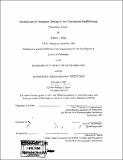Mechanisms of turbulent mixing in the Continental Shelf bottom boundary layer
Author(s)
Shaw, William J. (William James), 1971-
DownloadFull printable version (7.954Mb)
Other Contributors
Woods Hole Oceanographic Institution.
Advisor
John H. Trowbridge.
Terms of use
Metadata
Show full item recordAbstract
The bottom boundary layer is an important dynamical region of shallow water flows. In this thesis, the problem of turbulent mixing in the coastal bottom boundary layer is investigated with a unique set of field measurements of velocity and sound speed that span a significant fraction of the boundary layer obtained over a six-week long period in the late summer of 1996 on the New England shelf. The energetics of the turbulent fluctuations are investigated by testing simplified budgets for turbulent kinetic energy and scalar variance. The turbulent kinetic energy budget is locally balanced while the scalar variance budget is not, probably due to turbulent diffusion. The direct effects of stratification are consistently significant only in the outer part of the boundary layer, where the flux Richardson number is approximately equal to a critical value of 0.2. Turbulence closure is investigated in terms of non-dimensional profiles of velocity and sound speed. Close to the bottom, the results are consistent with Monin-Obukhov similarity theory, while in the outer part of the boundary layer other scales including the height of the boundary layer are important for setting the turbulent length scale.
Description
Thesis (Ph. D.)--Joint Program in Oceanography (Massachusetts Institute of Technology, Dept. of Earth, Atmospheric, and Planetary Sciences; and the Woods Hole Oceanographic Institution), February 2000. Includes bibliographic references.
Date issued
2000Department
Joint Program in Oceanography; Woods Hole Oceanographic Institution; Massachusetts Institute of Technology. Department of Ocean EngineeringPublisher
Massachusetts Institute of Technology
Keywords
Joint Program in Oceanography., Earth, Atmospheric, and Planetary Sciences., Woods Hole Oceanographic Institution.